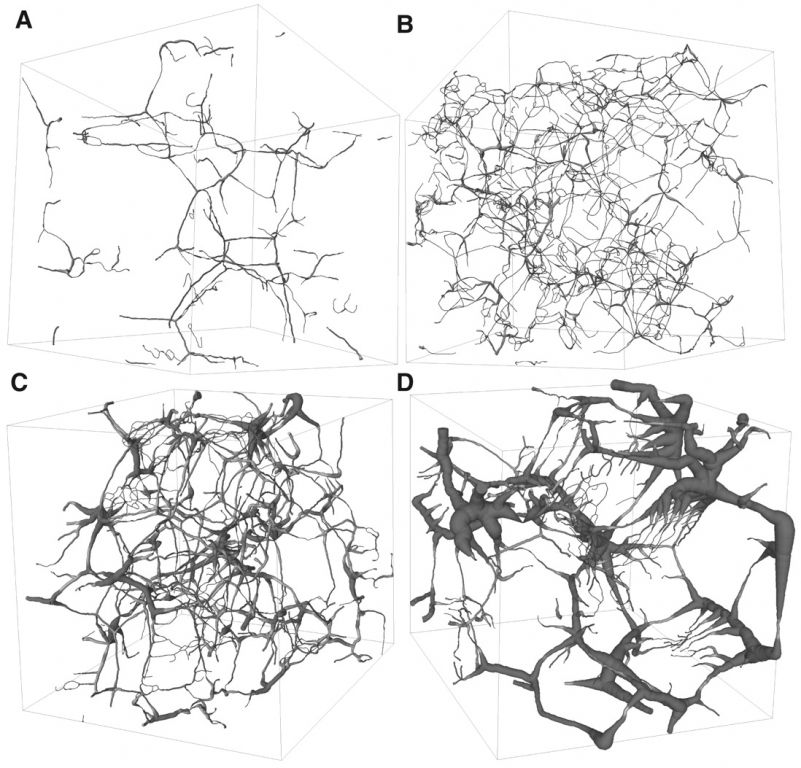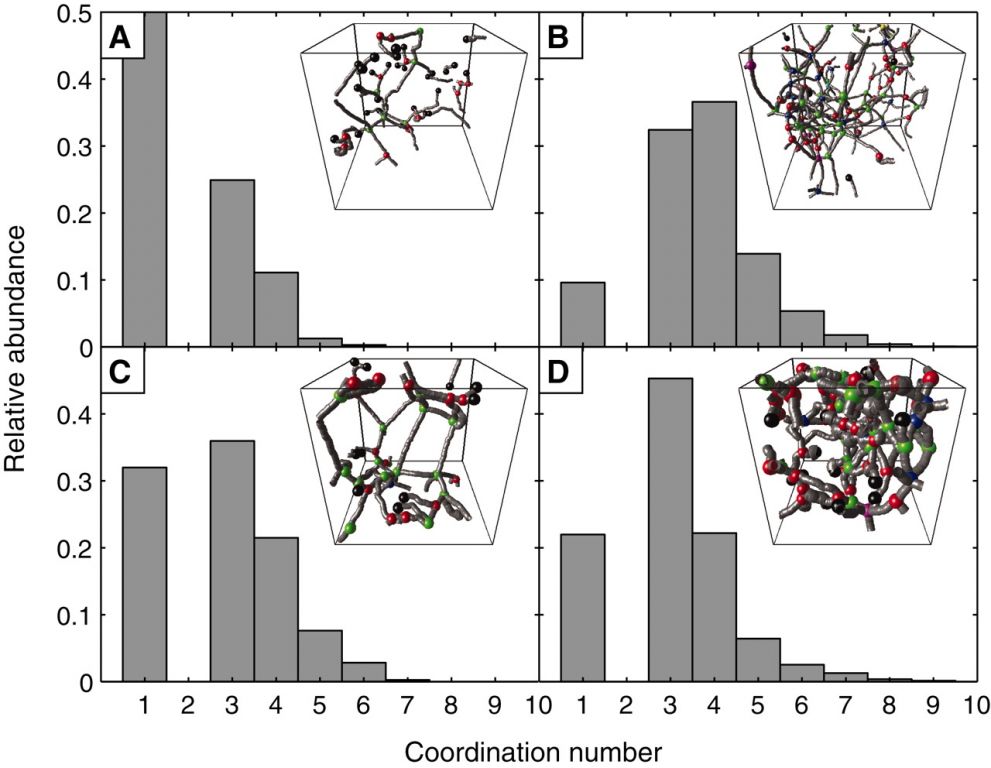博文
部分熔融岩石的微区成像研究:地幔橄榄岩中的三维熔体分布
|||
上地幔渗透率控制着扩张中心下的熔体分离。由于洋中脊出地球化学和地球物理观测存在着不一致,因此需要进一步认识部分熔融岩石中的迁移特征。利用X光同步微区成像技术,我们获得了含不同熔体比例的地幔橄榄岩的熔体分布三维数据。在熔体比例低至0.02时,沿颗粒边界的三联点控制着熔体构架;当熔体比例增加至0.2时,没有证据显示熔体萃取基本特征的突变。因此洋中脊下部分熔融区的孔隙度是由粘性固结作用和熔融速率之间的平衡来控制的,而不是由熔体拓扑关系(melt topology)的变化来控制的。
大洋扩张中心构造板块的离散包括下伏地幔岩的上涌和熔融作用。较轻的岩浆穿过地幔上升并集中于洋中脊轴向位置,不断产生新的洋壳(1,2)。尽管可能有高达20%的原始橄榄岩以这种方式熔融(3),但有效的熔体萃取使在地球物理观测数据中仅观测到1-3%的孔隙度(4,5)。洋中脊下观测到的大面积低波速异常意味着地幔是相对非渗透性的,具有大约0.02的孔隙度(4)。但是,大洋中脊玄武岩(MORBs)地球化学数据显示,岩浆一旦形成,它非常容易从残余橄榄岩中分离出来(6,7)。尤其是MORB中U系失衡(8-11)表明地幔是连接良好可渗透的,允许产生低于0.01熔体比例的萃取作用。
尽管结构平衡热动力学模型预测熔体残留于沿颗粒边缘的通道中(即三联点)(12,13),但是合成橄榄石-玄武岩集合体观测研究表明熔体既在颗粒边缘通道中存在同时也以颗粒边界薄膜形式存在(14,15)。当熔体比例Φ<0.02时如果颗粒边缘熔体通道及其稀少,而且他们以颗粒边界熔体薄膜形式连接(15),那么在低孔隙度条件下低渗透薄膜可能会限制整体的渗透性(14)。当Φ>0.02时,这些通道直接连通起来,渗透率会上升好几个数量级(14)。但是该模型是基于熔体分布的二维(2D)成像的。利用2D显微结构来定量推测3D熔体连通性,不可避免地会产生不确定性(14-17),尤其是在低熔体比例情况下。部分基于2D显微结构的研究显示在低至1%熔融条件下相互连通的熔体三联点的存在(16,17)。熔体的连通性也可以利用相似的体系来实验确定(18,19),但需要注意的是橄榄石-玄武岩体系的适用范围仍然不太清楚。
为克服2D数据的缺陷,我们利用X光同步微区成像技术来研究实验合成橄榄石-玄武岩集合体(20)中的3D熔体分布。这一无损成像技术具有0.7μm的空间分辨率,使我们可以在低熔体比例条件下进行熔体分布成像分析,并可以研究较大代表性区域中的熔体分布特点。

Fig. 1 Three-dimensional melt distribution of olivine basalt aggregates. The size of each cube is 140 μm by 140 μm by 140 μm. The melt volume fractions are (A) 0.02, (B) 0.05, (C) 0.10, and (D) 0.20. Gray represents the interfaces between melt and olivine crystals; red represents the interior of melt channels. The hollow space is where olivine crystals reside. Interconnected melt channels along grain edges are observed in all four samples.
3D复原结果显示,在0.02-0.20熔体比例条件下熔体通道沿着颗粒边缘形成了相互连通的构架(Fig.1 and movie S1),与相同体系的理论预测是一致的(12,13)。但是,橄榄石-玄武岩集合体中熔体分布比预计的要更加复杂,其中连通的熔体构架是不均一的。在Φ=0.10和0.20时,熔体同时润湿(wet)了颗粒边缘和相当一部分的颗粒边界(Fig.1 C and D)。在Φ=0.05时,熔体从颗粒边界处后退并主要沿着三联点分布(Fig.1B)。但在Φ=0.02时,熔体薄膜沿少量颗粒边界分布,与前人2D熔体分布研究结果一致(15),明显可以看到一个由直接连通的熔体通道所组成的构架(Fig.1A)。尽管我们的成像技术无法分辨纳米级厚度的熔体薄膜(15),但是所有样品中熔体通道连通构架的存在表明橄榄石-玄武岩体系的渗透率并未明显偏离幂律渗透率-孔隙度关系,即使在Φ=0.02条件下。

Fig. 2 Interconnectivity of melt channels in olivine-basalt aggregates with melt fractions of (A) 0.02, (B) 0.05, (C) 0.10, and (D) 0.20. The thickness of the channels is scaled to the actual size of the melt channel width. The multifurcation of channels along grain boundaries is an indication that the AVIZO skeletonization program (21) breaks down at grain boundary residing melt.
利用骨架化算法对熔体构架的连通性进行了分析,该算法系统减少了与指向中心的熔体通道正交的横截面。熔体通道中心处的线条以及这些线条的交点构成骨架(21)。所有样品中的骨架均显示三联点处的熔体形成了一个连通的构架(Fig.2)。
每个节点的配位数(相邻节点连接数)确定了构架的连通性(Fig.3)。在Φ=0.05时,4配位的节点是最多的,与理论预测结果一致(12,13);熔体构架是由颗粒边缘沿三联点分布的通道所控制的,终止于四个颗粒的连接点。在Φ=0.02时,1或3配位的节点比4配位的节点多,这可能是分辨率有限造成的;对熔体构架的详细考察表明大量的熔体通道仅由骨架化算法间歇性地确认出并会破裂。在Φ=0.10和0.20条件下样品中3配位节点的数量,代表了将颗粒角落较大的熔体池中的熔体通道分离出来时骨架化算法的极限(21)。尽管存在这些不确定性,我们的数据显示,缺乏证据表明单独的三联点的存在,在这样的三联点位置0.02-0.20比例条件下熔体薄膜控制着熔体连通性。

Fig. 3 Histogram of connectivity for samples with melt fraction of (A) 0.02 (m = 731), (B) 0.05 (m = 2622), (C) 0.10 (m = 1211), and (D) 0.20 (m = 875), where m is the number of nodes present in the simplified skeleton. The insets display a representative volume of the idealized network (bounding box is 100 μm by 100 μm by 100 μm) with melt channels shown as gray tubes and nodes as spheres color-coded for connectivity: 1, black; 3, red; 4, green; 5, blue; 6, magenta; 7 and above, yellow.
由于沿颗粒边缘的熔体通道比沿颗粒边界的熔体薄膜渗透容易(22),所以熔体比例和渗透率之间的幂律关系(13,19)仍然是橄榄石-玄武岩体系的一个很好的近似逼近,直到Φ=0.02条件下甚至更低。在该模型中,橄榄石-玄武岩体系的渗透率(K)与熔体比例(Φ)和颗粒大小(d)有关:k=Φnd2/C,这里C是一个几何因子(13)。在相同体系,已经数学推算出n=2,C=~1600-3000(13,23)。根据实验数据(19,24)也已经推算经验值n=3,C≈10-270。本研究中观测到的不均匀熔体分布表明n=3时可以获取更好的渗透率估计值(22,24)。d=3mm,Φ=0.02时,k=~10-12m2(13,22)。
洋中脊下熔体和速度的关系为:v=(k Δρ g)/(Φ η),这里Δρ=~300 kgm-3为熔体和固体地球之间的密度差异,g=~10 Pa为玄武岩熔体在流体状态时的粘度。结果得到v=~50 cm/year。MORB中Th失衡(9,10)在熔体速度比该估计值高1-2个数量级时才会存在,这可以用低C值(24),大颗粒度,削减的辉石含量(22)或者Φ>0.05来解释。对上地幔迁移特征进行准确估计需要加深对比简单橄榄石-玄武岩集合体更复杂的体系的3D熔体分布的认识。对于这些体系,简单渗透率关系无法解释颗粒尺度的复杂性(compexity)。采用高分辨率3D显微构造数据的晶格波尔兹曼法为模拟流体流动提供了一个非常有效的数学方法(25,26)。
但是,没有均一的渗透模型能够解释所观测到的(230Th/238U)和(226Ra/230Th)活性比的负相关关系(11)。因此,部分熔融地幔中的熔体迁移似乎是以强烈的通道化(channelization)为特征(27-29)。两种同时存在的熔体萃取构架使得有可能使地球化学和地球物理对洋中脊处熔体萃取的研究一致。微量元素亏损(6,27,28)和(230Th/238U)活性比(7)反应了高渗透性通道中的迁移特征,但是(230Th/238U)活性比(30),地震学数据(4)和电磁数据(5)对于一个缓慢的、扩散的、低孔隙度的迁移模型非常敏感。即使对于Φ低至0.01,熔体萃取速度仍远远超过地幔上涌速度。因此,地幔是非常干的,它的孔隙度是由固结粘性(24)和熔融速率(31)之间的平衡来控制的,而不是由渗透率-孔隙度关系转换来控制的。
(注:本文为原文翻译,相关数据请参考原文)
原文:http://www.sciencemag.org/content/332/6025/88.full
标题:Microtomography of Partially Molten Rocks: Three-Dimensional Melt Distribution in Mantle Peridotite
Supporting Online Material:http://www.sciencemag.org/content/suppl/2011/03/29/332.6025.88.DC1/Zhu.SOM.pdf
Movie S1:http://www.sciencemag.org/content/suppl/2011/03/29/332.6025.88.DC1/1202221s1.mov
参考文献:
- ↵D. W. Sparks, E. M. Parmentier, The structure of three-dimensional convection beneath oceanic spreading centres. Geophys. J. Int.112, 81 (1993). doi:10.1111/j.1365-246X.1993.tb01438.xCrossRef
- ↵L. B. Hebert, L. G. J. Montési, Generation of permeability barriers during melt extraction at mid-ocean ridges. Geochem. Geophys. Geosyst.11, Q12008 (2010). doi:10.1029/2010GC003270 CrossRef
- ↵P. D. Asimow, M. M. Hirschmann, M. S. Ghiorso, M. J. O’Hara, E. M. Stolper, The effect of pressure-induced solid-solid phase transitions on decompression melting of the mantle. Geochim. Cosmochim. Acta59, 4489 (1995). doi:10.1016/0016-7037(95)00252-U CrossRefWeb of Science
- ↵T. M. S. Team, The MELT Seismic Team, Imaging the deep seismic structure beneath a mid-ocean ridge: The MELT experiment. Science280, 1215 (1998). doi:10.1126/science.280.5367.1215 pmid:9596564 CrossRefMedlineWeb of Science
- ↵R. L. Evans et al., Asymmetric electrical structure in the mantle beneath the East Pacific Rise at 17°S. Science286, 752 (1999). doi:10.1126/science.286.5440.752 pmid:10531056 CrossRefMedlineWeb of Science
- ↵E. M. Klein, C. H. Langmuir, Global correlations of ocean ridge basalt chemistry with axial depth and crustal thickness. J. Geophys. Res.92 (B8), 8089 (1987). doi:10.1029/JB092iB08p08089 CrossRef
- ↵A. V. Sobolev, N. Shimizu, Ultra-depleted primary melt included in an olivine from the Mid-Atlantic Ridge. Nature363, 151 (1993). doi:10.1038/363151a0 CrossRef
- ↵M. Spiegelman, T. Elliott, Consequences of melt transport for uranium series disequilibrium in young lavas. Earth Planet. Sci. Lett.118, 1 (1993). doi:10.1016/0012-821X(93)90155-3 CrossRefWeb of Science
- ↵C. C. Lundstrom, J. B. Gill, Q. Williams, M. R. Perfit, Mantle melting and basalt extraction by equilibrium porous flow. Science270, 1958 (1995). doi:10.1126/science.270.5244.1958 Abstract/FREE Full Text
- ↵D. P. McKenzie, Constraints on melt generation and transport from U-series activity ratios. Chem. Geol.162, 81 (2000). doi:10.1016/S0009-2541(99)00126-6 CrossRefWeb of Science
- ↵K. W. W. Sims et al., Chemical and isotopic constraints on the generation and transport of magma beneath the East Pacific Rise. Geochim. Cosmochim. Acta66, 3481 (2002). doi:10.1016/S0016-7037(02)00909-2 CrossRefWeb of Science
- ↵C. S. Smith , Some elementary principles of polycrystalline microstructure. Metall. Rev.9, 1 (1964).
- ↵N. von Bargen, H. S. Waff, Permeabilities, interfacial areas and curvatures in partially molten systems: Results of numerical computations of equilibrium microstructures. J. Geophys. Res.91 (B9), 9261 (1986). doi:10.1029/JB091iB09p09261 CrossRef
- ↵U. H. Faul , Melt retention and segregation beneath mid-ocean ridges. Nature410, 920 (2001). doi:10.1038/35073556 pmid:11309614 CrossRef
- ↵M. Cmíral, J. D. Fitz Gerald, U. H. Faul, D. H. Green, A close look at dihedral angles and melt geometry in olivine-basalt aggregates; a TEM study. Contrib. Mineral. Petrol.130, 336 (1998). doi:10.1007/s004100050369 CrossRefWeb of Science
- ↵D. A. Wark, C. A. Williams, E. B. Watson, J. D. Price, Reassessment of pore shapes in microstructurally equilibrated rocks, with implications for permeability of the upper mantle. J. Geophys. Res.108, 2050 (2003). http://www.agu.org/journals/ABS/2003/2001JB001575.shtml doi:10.1029/2001JB001575 pmid:14686320 CrossRefMedline
- ↵M. J. Daines, F. M. Richter, An experimental method for directly determining the interconnectivity of melt in a partially molten system. Geophys. Res. Lett.15, 1459 (1988). doi:10.1029/GL015i013p01459 Web of Science
- ↵D. Laporte, E. B. Watson, Direct observation of near-equilibrium pore geometry in synthetic quartzites at 600°-800°C and 2-10.5 kbar. J. Geol.99, 873 (1991). doi:10.1086/629558 Web of Science
- ↵D. A. Wark, E. B. Watson, Grain-scale permeabilities of texturally equilibrated, monomineralic rocks. Earth Planet. Sci. Lett.164, 591 (1998). doi:10.1016/S0012-821X(98)00252-0 CrossRefWeb of Science
- ↵Synthetic olivine-basalt aggregates with melt fractions of 0.02, 0.05, 0.10, and 0.20 were equilibrated at 1.5 GPa and 1350°C (21).
- ↵Materials and methods are available as supporting material on Science Online.
- ↵W. Zhu, G. Hirth, A network model for permeability in partially molten rocks. Earth Planet. Sci. Lett.212, 407 (2003). doi:10.1016/S0012-821X(03)00264-4 CrossRefWeb of Science
- ↵M. J. Cheadle, M. T. Elliott, D. P. McKenzie, Percolation threshold and permeability of crystallizing igneous rocks: The importance of textural equilibrium. Geology32, 757 (2004). doi:10.1130/G20495.1 Abstract/FREE Full Text
- ↵J. A. D. Connolly, M. W. Schmidt, G. Solferino, N. Bagdassarov, Permeability of asthenospheric mantle and melt extraction rates at mid-ocean ridges. Nature462, 209 (2009). doi:10.1038/nature08517 pmid:19907492 CrossRefMedlineWeb of Science
- ↵O. van Genabeek, D. H. Rothman, Macroscopic manifestations of microscopic flows through porous media, Phenomenology from simulation. Annu. Rev. Earth Planet. Sci.24, 63 (1996). doi:10.1146/annurev.earth.24.1.63 CrossRefWeb of Science
- ↵J. T. Fredrich, A. A. DiGiovanni,D. R. Noble, Predicting macroscopic transport properties using microscopic image data. J. Geophys. Res.111 (B3), B03201 (2006). http://www.agu.org/journals/ABS/2006/2005JB003774.shtml doi:10.1029/2005JB003774 pmid:20411040 CrossRefMedline
- ↵S. R. Hart, Equilibration during mantle melting: A fractal tree model. Proc. Natl. Acad. Sci. U.S.A.90, 11914 (1993). doi:10.1073/pnas.90.24.11914 pmid:11607445 Abstract/FREE Full Text
- ↵P. B. Kelemen, N. Shimizu, V. J. M. Salters, Extraction of mid-ocean-ridge basalt from the upwelling mantle by focused flow of melt in dunite channels. Nature375, 747 (1995). doi:10.1038/375747a0 CrossRef
- ↵B. K. Holtzman et al., Melt segregation and strain partitioning: implications for seismic anisotropy and mantle flow. Science301, 1227 (2003). doi:10.1126/science.1087132 pmid:12947196 CrossRefMedlineWeb of Science
- ↵M. Jull, P. B. Kelemen, K. W. W. Sims, Consequences of diffuse and channelled porous melt migration on uranium series disequilibria. Geochim. Cosmochim. Acta66, 4133 (2002). doi:10.1016/S0016-7037(02)00984-5 CrossRefWeb of Science
- ↵M. Spiegelman, D. McKenzie, Simple 2-D models for melt extraction at mid-ocean ridges and island arcs. Earth Planet. Sci. Lett.83, 137 (1987). doi:10.1016/0012-821X(87)90057-4 CrossRefWeb of Science
- This work is supported by NSF-EAR 0753505 (W.Z. and G.A.G.) and NSF-OCE 0937277 (L.G.J.M.). F.F. was supported by the Western Australian State Government through the Premier’s Fellowship Program and the Australian Synchrotron Research Program, funded by the Commonwealth of Australia under the Major National Research Facilities Program. Use of the Advanced Photon Source was supported by the U.S. Department of Energy, Office of Science, Office of Basic Energy Sciences, under contract DE-AC02-06CH11357. We thank X. Xiao and J. Liu for their assistance. We furthermore acknowledge the Centre for Microscopy, Characterisation and Analysis for use of an electron microprobe and iVEC for use of their data storage and visualization facilities.
https://blog.sciencenet.cn/blog-92454-428766.html
上一篇:通向地幔之旅 Journey to the mantle of the Earth
下一篇:中国东北存在地幔柱吗?